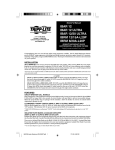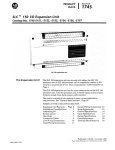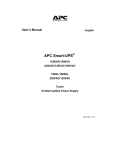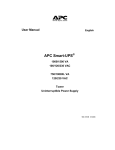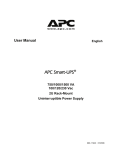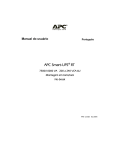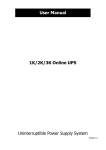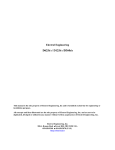Download Smart-UPS®
Transcript
User’s Manual English SmartSmart-UPS® 2200VA 120/230VAC 3000VA 120/208/230VAC 2U Rack Mount Uninterruptible Power Supply 990-1352 12/02 Introduction The APC Uninterruptible Power Supply (UPS) is designed to prevent blackouts, brownouts, sags, and surges from reaching your equipment. The uninterruptible power supply (UPS) filters small utility line fluctuations and isolates your equipment from large disturbances by internally disconnecting from the utility line. The UPS provides continuous power from its internal battery until the utility line returns to safe levels or the battery is fully discharged. 1: INSTALLATION Unpacking Attention: Read the safety instruction sheet before installation. Inspect the UPS upon receipt. Notify the carrier and dealer if there is damage. The packaging is recyclable; save it for reuse or dispose of it properly. Check the package contents: Attention: The UPS comes with battery disconnected and the front bezel packaged separately. UPS Front bezel Rail kit UPS literature kit containing: Smart-UPS® User Manuals CD PowerChute® CD Product documentation, safety and warranty information Serial and USB communication cables Rack mounting brackets EPO Connector Hardware 230V Model Only Main power cord Utility connector plug Alternate power cord (UK customers) Jumper cords Rail Installation Install the rails following the instructions in the rail kit. Positioning the UPS Attention: The UPS is heavy. Select a location sturdy enough to handle the weight. Do not operate the UPS in excessive dust or in temperature and humidity outside the specified limits. PLACEMENT 1 in (2.5 cm) 0-40°C 1 0-95% Mounting the UPS in a Rack Note: Illustrations in this document might differ slightly from your hardware. Install brackets as shown, or at a 5 in (12.7 Remove the battery module to lighten the cm) setback. UPS during installation. Note: The module is heavy. Install the UPS at or near the bottom of the Reinstall the module. rack. Make sure that the rack will not tip. Connect the battery. Attach the front bezel. 2 Connecting Equipment and Power to the UPS Startup 1. Connect equipment to the UPS. Rear Panels 120V: Note: A laser printer draws significantly more power than other types of equipment and may overload the UPS. 2. Add accessories to the Smart-Slot. 3. Plug the UPS into a two-pole, three-wire, grounded receptacle only. Avoid using extension cords. 120V/208V models: The power cord is attached to the UPS. The 120V model input plug is a NEMA L5-30R; the 208V model, a NEMA L6-30R. 230V model: The power cord is supplied in the UPS literature kit. Connect ground leads to the TVSS screw (optional). To make the connection, loosen the screw and connect the surge suppression device’s ground lead. Tighten the screw to secure the lead. 4. 230V: Basic Connectors Serial USB Port Port 120V model: Check the site wiring fault located on the rear panel. It will LED be illuminated if the UPS is plugged into an improperly wired utility power outlet (See Troubleshooting). 5. Turn on all connected equipment. To use the UPS as a master on/off switch, be sure all connected equipment is on. 6. Press the button on the front panel to power the UPS. • 7. 208V: TVSS Screw Use only interface kits approved by APC. Use only the supplied cable to connect to the Serial Port. A standard serial interface cable is incompatible with the UPS. Serial and USB Ports cannot be used simultaneously. The UPS features a transient voltage surgesuppression (TVSS) screw for connecting the ground lead on surge suppression devices such as telephone and network line protectors. The battery charges to 90% capacity during the first four hours of normal operation. Do not expect full battery run capability during this initial charge period. When connecting grounding cable, disconnect the UPS from utility power. For optimal computer system security, install PowerChute Smart-UPS monitoring software. 3 Emergency Power Off The Emergency Power Off (EPO) feature may be set up by the user. This will allow connected loads to immediately be deenergized from a remote location, without switching to battery operation. 1. Use the EPO connector supplied with the UPS. 2. Use a normally-open contact to connect the +24 terminal to the IN terminal. (see graphic) 3. Wire the four-pin connector to the EPO system. EPO Port (located on rear panel) EPO Connector IN +24 Attention: The EPO interface is a Safety Extra Low Voltage (SELV) circuit. Connect it only to other SELV circuits. The EPO interface monitors circuits that have no determined voltage potential. Such closure circuits may be provided by a switch or relay properly isolated from the utility. To avoid damage to the UPS, do not connect the EPO interface to any circuit other than a closure type circuit. 4 2: OPERATION Front Display Panel INDICATOR DESCRIPTION Online The UPS is supplying utility power to the connected equipment (see Troubleshooting). AVR Trim The UPS is compensating for a high utility voltage. AVR Boost The UPS is compensating for a low utility voltage. On Battery The UPS is supplying battery power to the connected equipment. Overload The connected loads are drawing more than the UPS power rating (see Troubleshooting). Replace Battery/ Battery Disconnected The battery is disconnected or must be replaced (see Troubleshooting). FEATURE FUNCTION Power On Press this button to turn on the UPS. (Read on for additional capabilities.) Power Off Press this button to turn off the UPS. 5 FEATURE FUNCTION Self-Test Automatic: The UPS performs a self-test automatically when turned on, and every two weeks thereafter (by default). During the self-test, the UPS briefly operates the connected equipment on battery. Manual: Press and hold the test. Cold Start button for a few seconds to initiate the self- Supply immediate battery power to the UPS and connected equipment (see button for one second and release. The UPS Troubleshooting). Press the will beep briefly and go quiet. Press and hold the button again, but for approximately three seconds. The unit will emit a sustained beep. Release the button during this beep. Diagnostic Utility Voltage The UPS has a diagnostic feature that displays the utility voltage. The UPS starts a self-test as part of this procedure. The self-test does not affect the voltage display. button to view the utility voltage bar graph display. Press and hold the After a few seconds, this five-LED battery charge display on the right of the front panel will show the utility input voltage. Refer to the figure at left for the voltage reading (values are not listed on the UPS). The display indicates the voltage is between the displayed value on the list and the next higher value (see Troubleshooting). On Battery Operation The UPS switches to battery operation automatically if the utility power fails. While running on battery, an alarm beeps four times every 30 seconds. button to silence this alarm. If the utility power does not return, the UPS continues to Press the supply power to the connected equipment until the battery is fully discharged. If PowerChute is not being used, files must be manually saved and the computer must be turned off before the UPS fully discharges the battery. The UPS battery life differs based on usage and environment. Refer to www.apc.com for on battery runtimes. 6 3: USER CONFIGURABLE ITEMS NOTE: SETTINGS ARE ADJUSTED THROUGH THE SUPPLIED POWERCHUTE SOFTWARE OR OPTIONAL SMART SLOT ACCESSORY CARDS. FUNCTION FACTORY DEFAULT USER SELECTABLE CHOICES DESCRIPTION Automatic SelfTest Every 14 days (336 hours) Every 7 days (168 hours), On Startup Only, No Self-Test Set the interval at which the UPS will execute a self-test. UPS ID UPS_IDEN Up to eight characters (alphanumeric) Uniquely identify the UPS, (i.e. server name or location) for network management purposes. Date of Last Battery Replacement Manufacture Date mm/dd/yy Reset this date when you replace the battery module. Minimum Capacity Before Return from Shutdown 0 percent 0, 15, 30, 45, 50, 60, 75, 90 percent Specify the percentage to which batteries will be charged following a lowbattery shutdown before powering connected equipment. Voltage Sensitivity The UPS detects and reacts to line voltage distortions by transferring to battery operation to protect connected equipment. High : No illumination; low sensitivity. Adjust by pressing the voltage (rear panel). Use sensitivity button a pointed object (such as a pen) to do so. Note: In situations of poor power quality, the UPS may frequently transfer to battery operation. If the connected equipment can operate normally under such conditions, reduce the sensitivity setting to conserve battery capacity and service life. : Brightly illuminated - high sensitivity. : Dimly illuminated - medium sensitivity. Alarm Delay Control Enable Enable, Mute, Disable Mute ongoing alarms or disable all alarms permanently. Shutdown Delay 90 seconds 0, 90, 180, 270, 360, 450, 540, 630 seconds Set the interval between the time when the UPS receives a shutdown command and the actual shutdown. 7 NOTE: SETTINGS ARE ADJUSTED THROUGH THE SUPPLIED POWERCHUTE SOFTWARE OR OPTIONAL SMART SLOT ACCESSORY CARDS. FUNCTION Low Battery Warning FACTORY DEFAULT 2 minutes PowerChute software provides automatic, unattended shutdown when approximately 2 minutes of battery operated runtime remains. USER SELECTABLE CHOICES : Brightly illuminated - low battery warning level of about 2 minutes. : Dimly illuminated - low battery warning level of about 5 minutes. : No illumination; low battery warning level is approximately 8 minutes. DESCRIPTION The UPS will beep when 2 minutes of battery runtime remains. Change the warning interval setting by pressing the voltage sensitivity button, while pressing and holding the button. Change the low battery warning interval setting to the time that the operating system or system software requires to safely shut down. Synchronized Turn-on Delay 0 seconds 0, 60, 120, 180, 240, 300, 360, 420 seconds Specify the time the UPS will wait after the return of utility power before turn-on (to avoid branch circuit overload). High Transfer Point 120V model: 127VAC 120V model: 127, 130, 133, 136VAC 208V model: 225VAC 208V model: 225, 229, 233, 237VAC Set the high transfer point higher to avoid unnecessary battery usage when the utility voltage is usually high and the connected equipment is specified to operate with input voltages this high. 230V model: 253VAC 230V model: 253, 257, 261, 265VAC 120V model: 106VAC 120V model: 97, 100, 103, 106VAC 208V model: 182VAC 208V model: 170, 174, 178, 182VAC 230V model: 208VAC 230V model: 196, 200, 204, 208VAC 230VAC 220, 230, 240VAC Low Transfer Point Output Voltage (230V Model Only) 8 Set the low transfer point lower when the utility voltage is usually low and the connected equipment is specified to operate with input voltages this low. Select the output voltage. 4: STORAGE, MAINTENANCE, TRANSPORTING, AND SERVICE Storage Service Store the UPS covered in a cool, dry location, with the batteries fully charged. If the UPS requires service do not return it to the dealer. Follow these steps: At -15 to +30 °C (+5 to +86 °F), charge the UPS battery every six months. At +30 to +45 °C (+86 to +113 °F), charge the UPS battery every three months. 1. Review the problems discussed in Troubleshooting to eliminate common problems. 2. If the problem persists, contact APC Customer Service through the APC web site, www.apc.com/support. Note the model number of the UPS, the serial number, and the date purchased. If you call APC Customer Service, a technician will ask you to describe the problem and attempt to solve it over the phone. If this is not possible, the technician will issue a Returned Material Authorization Number (RMA#). If the UPS is under warranty, repairs are free. 3. Pack the UPS in its original packaging. If this is not available, refer to www.apc.com/support for information about obtaining a new set. Replacing the Battery Module The UPS battery life differs based on usage and environment. Consider replacing the battery every three years. This UPS has an easy to replace, hot-swappable battery module. Replacement is a safe procedure, isolated from electrical hazards. You may leave the UPS and connected equipment on during the replacement procedure. See your dealer or contact APC at www.apc.com for information on replacement battery modules. Note: Upon battery disconnection, equipment is not protected from power outages. Refer to Mounting the UPS in a Rack for instructions on battery removal and replacement. Be sure to deliver the spent battery to a recycling facility or ship it to APC in the replacement battery packing material. Transporting 1. Shut down and disconnect any equipment attached to the UPS. Pack the UPS properly to avoid damage in transit. Never use Styrofoam beads for packaging. Damage sustained in transit is not covered under warranty. Always DISCONNECT THE BATTERY before shipping in compliance with U.S. Department of Transportation (DOT) regulations. The battery may remain in the UPS; it does not have to be removed. 4. Mark the RMA# on the outside of the package. Return the UPS by insured, prepaid carrier to the address given to you by Customer Service. 2. Shut down the UPS, and disconnect the UPS from the utility power outlet. 5. 3. Remove the front bezel, and unplug the battery connector. Contact Information U.S. Customers - Refer to www.apc.com/support. For shipping instructions and to obtain appropriate packing materials, refer to www.apc.com/support/contact. International Customers - Refer to www.apc.com, select the appropriate country from the country selection field, and select the Support tab at the top of the web page. 9 5: TROUBLESHOOTING Use the chart below to solve minor UPS installation and operation problems. Refer to www.apc.com with complex UPS problems. SOLUTION PROBLEM AND/OR POSSIBLE CAUSE UPS WILL NOT TURN ON Battery not connected properly. button not pushed. Check that the battery connector is fully snapped into position. Press the button once to power the UPS and the connected equipment. UPS not connected to utility power supply. Check that the power cord is securely connected at both ends. Very low or no utility voltage present. Check the utility power supply to the UPS by plugging in a table lamp. If the light is very dim, have the utility voltage checked. UPS WILL NOT TURN OFF The UPS is experiencing an internal fault. Do not attempt to use the UPS. Unplug the UPS and have it serviced immediately. UPS BEEPS OCCASIONALLY Normal operating UPS beeps when running on battery. None. The UPS is protecting the connected equipment from occasional utility power irregularities. UPS IS NOT PROVIDING EXPECTED BACKUP TIME The UPS battery is weak due to a recent outage or is near the end of the service life. Charge the battery. Batteries require recharging after extended outages. They can wear faster when put into service often or when operated at elevated temperatures. If the battery is near the end of the service life, consider replacing the battery even if the replace battery LED is not yet illuminated. ALL LEDS ARE ILLUMINATED AND THE UPS EMITS A CONSTANT BEEPING The UPS is experiencing an internal fault. Do not attempt to use the UPS. Turn off the UPS and have it serviced immediately. FRONT PANEL LEDS FLASH SEQUENTIALLY The UPS has been shut down remotely through software or an optional accessory card. None. The UPS will restart automatically when utility power returns. ALL LEDS ARE OFF AND THE UPS IS PLUGGED INTO A WALL OUTLET The UPS is shut down or the battery is discharged from an extended outage. None. The UPS will return to normal operation when the power is restored and the battery has a sufficient charge. 10 SOLUTION PROBLEM AND/OR POSSIBLE CAUSE THE OVERLOAD LED IS ILLUMINATED AND THE UPS EMITS A SUSTAINED ALARM TONE The UPS is overloaded. The connected equipment exceeds the “maximum load,” as defined in Specifications at www.apc.com. The alarm remains on until the overload is removed. Disconnect nonessential equipment from the UPS. The UPS continues to supply power as long as it is online and the circuit breaker does not trip; the UPS will not provide power from batteries in the event of a utility voltage interruption. If a continuous overload occurs while the UPS is on battery, the unit turns off output in order to protect the UPS from possible damage. THE REPLACE BATTERY/BATTERY DISCONNECTED LED IS ILLUMINATED This LED flashes and short beep is emitted every two seconds to indicate the battery is disconnected. Check that the battery connectors are fully engaged. Weak battery. Allow the battery to recharge for 24 hours and perform a self-test. If the problem persists after recharging, replace the battery. Failure of a battery self-test. This LED is illuminated and the UPS emits short beeps for one minute. The UPS repeats the alarm every five hours. Allow the battery to recharge for 24 hours and perform another self-test to confirm the replace battery condition. If the battery passes the self-test, the alarm will stop and the LED will clear. If the battery fails again, it must be replaced. The connected equipment is unaffected. THE SITE WIRING FAULT LED ON THE REAR PANEL IS ILLUMINATED (120V MODEL ONLY) The UPS is plugged into an improperly wired utility power outlet. Wiring faults detected include missing ground, hot-neutral polarity reversal, and overloaded neutral circuit. Contact a qualified electrician to correct the building wiring. THE INPUT CIRCUIT BREAKER TRIPS The UPS is overloaded. Reduce the load on the UPS by unplugging equipment. Reset the breaker. THE AVR BOOST OR AVR TRIM LEDS ARE ILLUMINATED Your system is experiencing a period of low or high voltage. Have qualified service personnel check your facility for electrical problems. If the problem continues, contact the utility company for further assistance. THERE IS NO UTILITY POWER There is no utility power and the UPS is off. Use the Cold Start feature to supply power to the connected equipment from the UPS battery. Press the button for one second and release. The UPS will beep briefly and go quiet. Press and hold the button again for about three seconds. The unit will emit a sustained beep. Release the button during this beep. This will supply immediate power to the UPS and the connected equipment. 11 SOLUTION PROBLEM AND/OR POSSIBLE CAUSE UPS OPERATES ON BATTERY ALTHOUGH NORMAL LINE VOLTAGE EXISTS The UPS input circuit breaker tripped. Reduce the load on the UPS by unplugging equipment. Reset the breaker. Very high, low, or distorted line voltage. Move the UPS to a different outlet on a different circuit; inexpensive fuel powered generators may distort the voltage. Test the input voltage with the utility voltage display (see Operation). If acceptable to the connected equipment, reduce the UPS sensitivity. BATTERY CHARGE AND LOAD LEDS FLASH SIMULTANEOUSLY The UPS has shutdown. Check that the room temperature is within the specified limits for operation. The internal temperature of the UPS has exceeded the allowable threshold for safe operation. Check that the UPS is properly installed, allowing for adequate ventilation. Allow the UPS to cool down. Restart the UPS. If the problem continues, contact APC at www.apc.com/support. DIAGNOSTIC UTILITY VOLTAGE All five LEDs are illuminated. The line voltage is extremely high and should be checked by an electrician. There is no LED illumination. If the UPS is plugged into a properly functioning utility power outlet, the line voltage is extremely low. ONLINE LED There is no illumination. The UPS is running on battery, or it must be turned on. The LED is blinking. The UPS is running an internal self-test. 12 6: REGULATORY AND WARRANTY INFORMATION Regulatory Agency Approvals and Radio Frequency Warnings 120V/208V models 230V models This equipment has been tested and found to comply with the limits for a Class A digital device, pursuant to part 15 of the FCC Rules. These limits are designed to provide reasonable protection against harmful interference when the equipment is operated in a commercial environment. This equipment generates, uses, and can radiate radio frequency energy and, if not installed and used in accordance with the instruction manual, may cause harmful interference to radio communications. Operation of this equipment in a residential area is likely to cause harmful interference in which case the user will be required to correct the interference at his/her own expense. This is a Class A product. In a domestic environment this product may cause radio interference, in which case the user may be required to take corrective actions. Shielded signal cables must be used with this product to ensure compliance with the Class A FCC limits. Declaration of Conformity Entire contents copyright © 2003 by American Power Conversion Corporation. All rights reserved. Reproduction in whole or in part without permission is prohibited. APC, Smart-UPS, and PowerChute are registered trademarks of American Power Conversion Corporation. All other trademarks are the property of their respective owners. 13





















